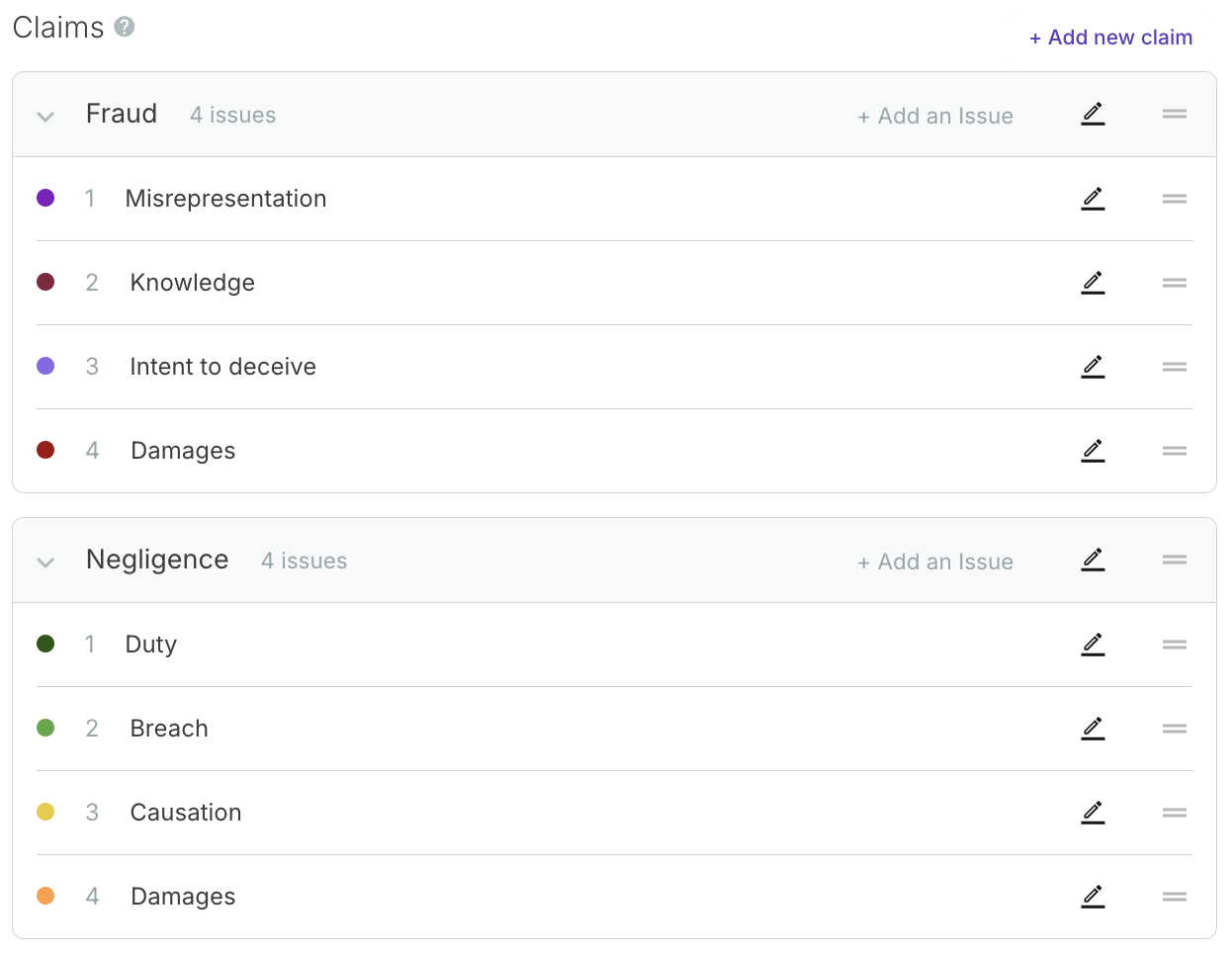
Introduction
Properly labeling facts and evidence in Casefleet, along with crafting a detailed case outline, streamlines the legal process and enhances case organization, leading to improved analysis and better outcomes. This blog aims to help new users of Casefleet get up to speed with the crucial task of setting up a case outline and clearly labeling the various elements you’re trying to prove.
Testing and practice are the quickest ways to master the facts and organize your case narrative in Casefleet, and the following tips will help you learn how to efficiently leverage issues and claims to build out a solid case strategy.
Understanding the basics
What is fact management?
In a legal context, "fact management" refers to the process of organizing, analyzing, and leveraging the facts pertinent to your case. This is crucial in legal proceedings where a clear understanding and presentation of the facts can influence the outcome.
Effective fact management helps you maintain a clear understanding of the case, prepare for litigation, and ensure that no crucial information is overlooked. It's especially critical in complex cases involving large volumes of data and numerous factual issues.
What are case outlines?
A case outline is a structured summary of a legal case used to organize your arguments and prepare for litigation. A well-prepared case outline serves as a roadmap for trial, helping to structure how you want to present the case and to ensure your arguments are clear and compelling.
Typically, a case outline refers to a unified document that captures the complete strategy and structure of your case. It also helps identify potential gaps in your arguments to ensure that all critical elements are covered.
What are issues and claims?
In Casefleet, issues are categories and labels used to tag facts, often showing how they relate to elements of a legal claim. Claims group related issues together, creating “buckets” that help organize the case around specific legal disputes.
For instance, in a slip-and-fall incident, you may want to organize certain facts of your case around a negligence claim, categorizing them with specific issue tags indicating the defendant’s “Duty” or obligation to follow certain standards of conduct, "Breach" to indicate when those duties were not fulfilled, and and "Damages" that were incurred to the plaintiff.
Issue tags can also be used outside of a claim group to indicate categories that don't fit into specific legal claims, such as a tag for all "Key Facts" or "Disputed" events.
Labeling facts and evidence
Methods for adding facts
- Highlight text: Annotate documents by highlighting text to create facts.
- Cite page button: Use the toolbar's cite page button for citing entire exhibits or documents.
- Create facts on the facts tab: Add facts directly on the facts tab for oral or non-documented information.
When creating facts, paraphrase the source text if needed, tag relevant entities (contacts), assign dates/times, link issues and claims, add notes, and save. These facts will be automatically added to your case chronology.
Creating a fact in the document reviewer:

Fact populated on the Facts tab:

(Learn more about best practices for creating facts here)
Labeling evidence
When starting a new case, it’s beneficial to input relevant issues and claim templates that align with your case. This initial setup helps establish a clear framework for your case strategy from the onset.
As the case progresses and your arguments become more refined, you can easily modify these labels to better fit the evolving details.
Examples:
- Issue label: “Damages”
Description: Evidence of harm or loss, like medical bills or repair invoices. - Issue label: “Adverse action”
Description: Evidence of negative actions, such as termination notices or disciplinary actions. - Issue label: “Knowledge”
Description: Evidence showing awareness of a condition or fact, like a record of known hazards. - Issue label: “Implied consent”
Description: Evidence suggesting consent was given indirectly, like signed waivers. - Issue label: “Direct evidence of discrimination”
Description: Evidence of discriminatory behavior, like biased performance reviews. - Issue label: "Motivation”
Description: Evidence revealing reasons behind actions, such as financial motivations for termination.
Labeling facts and evidence
Structure claims to outline your case arguments
Examples include:

Customize issue and claims order
Adjust the order of issues and claims in the Issues tab. This impacts the order of the Facts by Issues report, providing a tailored overview of your case status.
Use case examples
Medical chronology
Tag issues like "Clinical notes" or "Standard of care" to group and organize medical facts and evidence.
Criminal law cases
Use issue tags like "Self-defense" or "Causation" to outline arguments and organize facts by category.
Personal injury cases
Tag issues such as "Liability" and "Damages" to organize facts related to the cause of injury and extent of damages.
Family cases
Tag issues such as "Custody" and "Property division" to organize facts related to the cause of injury and extent of damages.
Tips and best practices
Consistency in labeling
- Maintain consistent labeling for better organization and analysis.
- Collaborate with your team to ensure uniformity in issue and claim tagging.
Regular updates and reviews
- Keep your case outline updated with new facts and evidence.
- Regularly review and refine your outline for accuracy and completeness.
- Export the “Facts by issues” report to track progress and identify gaps.
Cross-referencing
- Cross-reference facts and evidence within your outline to illustrate relationships and strengthen arguments.
- Link relevant facts, attach additional supporting evidence, and merge facts as needed.
Utilizing Casefleet features
- Use the highlight context menu, default issue tags, and claim templates to enhance efficiency.
- Explore advanced full-text search, robust filters, and customizable report options for efficient case management.
- Utilize Casefleet’s bulk archive feature to refine your case outline and focus on essential facts.
Casefleet support and resources
Help and support
Casefleet offers a range of support resources, including a help center, tutorials, and customer support. For assistance, use in-app chat, email us at support@casefleet.com, or call 1-800-968-3994.
Conclusion
Effective case management relies on proper labeling and detailed case outlines. Casefleet’s tools streamline these tasks, improving organization and analysis.
See how Casefleet can enhance your case management by scheduling a personalized demo. Experience how our software meets your needs and answers your questions.
Ready to start? Begin your 14-day free trial to explore Casefleet’s features and organize your cases with ease. Contact our team for any questions or support.